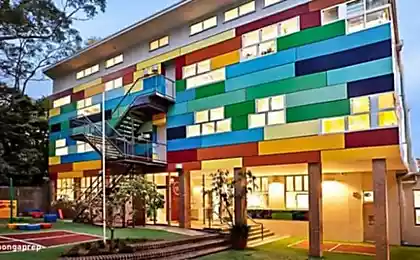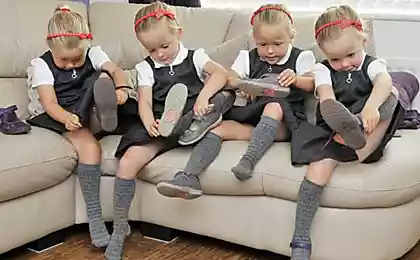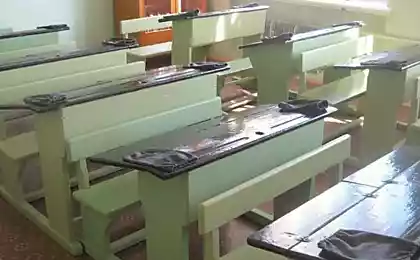219
Why in the United States single desks, and our children sit only in pairs
Schools in America are quite different from European ones. And this is not strange, because each country has its own traditions, views and beliefs. Sometimes they may coincide, and somewhere the school differences will be maximum. For example, we are all used to sitting at a desk with a friend, but in overseas schools - one at a time. There are others. Interesting facts about schools Other countries? We'll tell you.

Let all of us have become accustomed to some common moments. For example, that two-persons usually They're moving in. Or leave it for the second year. Moreover, all together study the same subjects and sit at the same desk for a dozen years. By the way, we'll start with the desk.

In all American films about school, you can see that children have single desks. Although in fact, such desks are not only in America, but also in some countries of Europe and Asia. Teachers are convinced that the desk is the personal space of each child. Just like his locker, textbooks, stationery.
Single desk. piece every student in the school. Moreover, it contributes to the development of independence. The child simply has no one to write off, and the neighbor on the desk will not forget that yesterday the books agreed to take in half.
427364
The tradition of seating students in two came to us from the distant XIX century. This allowed to divide the missing textbooks into two, save space and replace the usual lockers with large countertops.
At that time, let's face it, lowly Individuality and personal boundaries. Everything was common. This tradition has persisted for quite a long time, although more and more schools are adopting new methods. This will help to improve the comfort of children during the learning process.
Moreover, in American schools there is no opportunity to sit next to a girlfriend throughout the school time. These changes are believed to contribute to early socialization baby. After all, he will communicate with different people, see different characters, try to find an approach to them and build communication.

Schools in America and their main differences are changing, by the way, not only students, but also teachers. More specifically, class leaders. And this also contributes to the active socialization of the child, because each teacher has his own approach to the presentation of material.
In fact, American schools have enough. clear-cut levels. These are elementary, middle, high school and correspond to the already familiar elementary, middle and high school. Only it is all in different buildings, unlike the usual classes.

Has it ever happened that one of the seniors asked what class you were in, and then complained that soon you will learn a certain poem or work? Most likely, the school curriculum in most cases is one for everyone. Everyone remembers when he learned the familiar “Lukomorye oak green...”, as well as the hated logarithms and integrals from high school.
Schools in America have a slightly different approach to creating a curriculum. For each state is developed manualwhere the main points are collected. The teacher has the right to independently select textbooks, submission of material and what can be missed from the curriculum.

Of course, every country can boast of interesting moments that would concern schooling. For example, Chinese children can be called real workers. Competition in Chinese universities is extremely high, so children are forced to study extremely much. supplement Or go to tutors.

In Finland, there is no strict division of the school day into lessons. The teacher adheres to the curriculum, but in a free form. This is intended to ensure that separate Strong and weak students, because they also have the right not to go to the board if they do not want to.

Each country builds the process of schooling, according to established traditions, mentality and many other indicators. The fact that learning is different everywhere is wonderful. After all, the main thing is that children are comfortable in the walls of the educational institution, and knowledge. learn quickly, easily and interestingly.

Let all of us have become accustomed to some common moments. For example, that two-persons usually They're moving in. Or leave it for the second year. Moreover, all together study the same subjects and sit at the same desk for a dozen years. By the way, we'll start with the desk.

In all American films about school, you can see that children have single desks. Although in fact, such desks are not only in America, but also in some countries of Europe and Asia. Teachers are convinced that the desk is the personal space of each child. Just like his locker, textbooks, stationery.
Single desk. piece every student in the school. Moreover, it contributes to the development of independence. The child simply has no one to write off, and the neighbor on the desk will not forget that yesterday the books agreed to take in half.
427364
The tradition of seating students in two came to us from the distant XIX century. This allowed to divide the missing textbooks into two, save space and replace the usual lockers with large countertops.
At that time, let's face it, lowly Individuality and personal boundaries. Everything was common. This tradition has persisted for quite a long time, although more and more schools are adopting new methods. This will help to improve the comfort of children during the learning process.
Moreover, in American schools there is no opportunity to sit next to a girlfriend throughout the school time. These changes are believed to contribute to early socialization baby. After all, he will communicate with different people, see different characters, try to find an approach to them and build communication.

Schools in America and their main differences are changing, by the way, not only students, but also teachers. More specifically, class leaders. And this also contributes to the active socialization of the child, because each teacher has his own approach to the presentation of material.
In fact, American schools have enough. clear-cut levels. These are elementary, middle, high school and correspond to the already familiar elementary, middle and high school. Only it is all in different buildings, unlike the usual classes.

Has it ever happened that one of the seniors asked what class you were in, and then complained that soon you will learn a certain poem or work? Most likely, the school curriculum in most cases is one for everyone. Everyone remembers when he learned the familiar “Lukomorye oak green...”, as well as the hated logarithms and integrals from high school.
Schools in America have a slightly different approach to creating a curriculum. For each state is developed manualwhere the main points are collected. The teacher has the right to independently select textbooks, submission of material and what can be missed from the curriculum.

Of course, every country can boast of interesting moments that would concern schooling. For example, Chinese children can be called real workers. Competition in Chinese universities is extremely high, so children are forced to study extremely much. supplement Or go to tutors.

In Finland, there is no strict division of the school day into lessons. The teacher adheres to the curriculum, but in a free form. This is intended to ensure that separate Strong and weak students, because they also have the right not to go to the board if they do not want to.

Each country builds the process of schooling, according to established traditions, mentality and many other indicators. The fact that learning is different everywhere is wonderful. After all, the main thing is that children are comfortable in the walls of the educational institution, and knowledge. learn quickly, easily and interestingly.
Visionary Pavel Globa prepared a horoscope for the second half of 2021
Prayer for children on July 9, on the day of the Tikhvin Icon of the Mother of God























